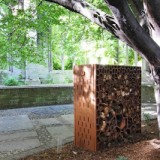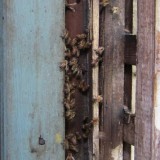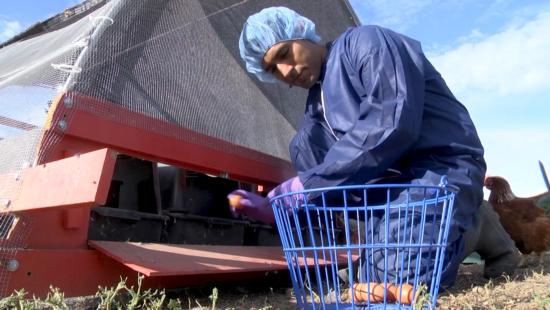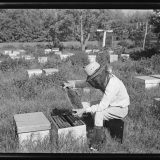
Four years ago I built a wooden hive stand like the one above. I’m retracting this idea. Why? In short, termites. A healthy bee colony can live for years and once you find a place they like there’s no reason to move them. They are also really heavy, with a large colony weighing as much as a person. The problem with wooden stands is that even if you use treated lumber they will eventually succumb to termites, especially in our warm climate. Combine termites with playful young raccoons and you end up with a disaster. Let me propose two alternatives:
- Cinder blocks are inexpensive, strong and last forever. It’s harder to do ant control with them but I gave up on that years ago. Healthy hives, in my experience, fend off ants themselves.
- Buy or weld your own metal stands.
You may want to consider strapping the hives down if you live in a windy place or in earthquake country. See Eric of Garden Fork TV’s video on this. I also wish that I had small concrete pads underneath the hives.
Do you use a stand? What kind do you use?




what sort of small concrete pad underneath? Large flagstone sort of thing? And why?
I wish I had poured a proper concrete pad for additional stability. Flagstones are not as stable. That said, I wasn’t sure that I had the right spot when I placed the hives where they are now.
We have our hives on a stand that John built from pressure-treated 4″ x 4″ lumbers. Yes, pressure treated wood is an issue, but this replaced a stand built from pallet wood that rotted away. I worried that an especially heavy snow would cause the stand to collapse in winter, exposing bees to the cold and possibly killing them.
In order to make best use of the lumber with no waste, the stand is the full length of the wood; cross pieces are cut to 2′ so as to avoid waste on the other pieces. We can easily fit three hives on each stand with comfortable space between them.
Oh, and there aren’t any termites in Vermont – at least that’s what all the home inspectors and carpenters around here say. We’ve never heard of any.
I made up a system that works very well. I use a plastic “burlap” bag, the sort of woven tarp material that sandbags or large rice sacks are made of. Mine are actually rice sacks.
I put in several shovelfuls of Sharp Crush, a sand and rock mix that packs into a hard surface for driveways or whatever. Then, just drop the bag where you want it, fold the top over and tuck it under the bottom.
Then take your 18″ concrete paver and just drop it onto the bag several times, checking with the level and adjusting your drop angle as needed.
This packs the crush down into a very firm base that has supported my hives with no trouble.
Need to move your hive? Just pick up the bag and repeat in the new spot. This is so much easier than trying to wedge up hives or whatever.
I use the plastic boxes used for bottles. They are strong and very colored.
https://www.google.it/search?q=cassetta+plastica+portabottiglie&safe=active&source=lnms&tbm=isch&sa=X&ved=0CAcQ_AUoAWoVChMI4sPv64KKyAIVh7QaCh2BHg_r&biw=1258&bih=699
I use 2×2’s for legs and stick them in empty tuna fish cans filled with used motor oil for ant protection. No problem with dry rot or termites.
Cinder blocks for me. I get some ants on my inner cover, but I don’t think they can get to the opening on my inverted bucket feeder. They just clean up the drips that fall when I’m getting the feeder in place. The bees don’t seem to be bothered by them.
Pierce Mieras bee supply shop in Fullerton, Orange county do a very nice rebar welded steel hive stand for about $30 last time I was there.